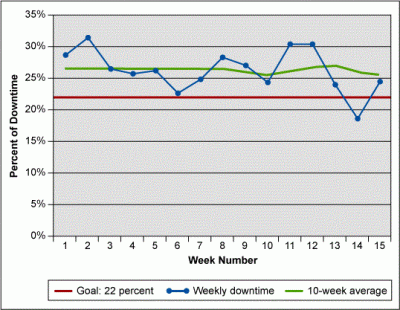Whether one works in manufacturing, a service field, or healthcare, it is important to understand how each step of a process from the supply chain to delivery is performing. Process indicators are proven tools to help every level of a company clearly understand goals, targets, and results.
Overview: What is a process indicator?
Process indicators allow an organization to measure the performance of processes throughout their entire system. By quantifying performance at each stage of operations, a clear picture of process execution emerges.
3 benefits of using process indicators
Quantified information is not subjective, but rather offers objective feedback regarding the performance throughout a process.
1. Provision of tools for system optimization
Manufacturing performance indicators can be used by analysts to optimize operations. For example, one common manufacturing PPI is a measurement of throughput on an assembly line. By charting the data, engineers may become aware of a segment of the line that holds up production on a regular basis.
This information could be coupled with key performance indicators (KPIs) that track unplanned downtime of equipment to allow management and engineers to focus on a piece of equipment that needs an adjusted maintenance schedule or has been regularly failing due to a bulk order of defective replacement parts.
2. Ability to perform operational performance for decision making
One can readily understand the need to quantify accounting to make sure a company is profitable, allowing staff to make daily decisions about the use of resources. Similarly, operational efficiency must be quantified so that decisions can be made to add to the overall efficiency of the company.
For example, if a manufacturing system has a ‘bottle neck’ because of issues with an unreliable separations mechanism, management can quantify the losses involved and perform an economic analysis. This data allows them to decide how many research and development resources and equipment purchases can be justifiably used to solve the problem.
3. Use of quantifiers for review and predictive modeling
Tracking quantifiers gives clear information that can be easily plotted. By creating trend charts, one can swiftly relay information to teams. Result quantifiers that are associated with the measurement of results and process quantifiers, which track process measurables, can both be charted and compared. The resulting data may be used to review or predict trends within an organization.
Why are process indicators important to understand?
Understanding process indicators puts you in a position of value in your company in 3 ways.
1. Demonstrates that you are forward thinking
Following process indicators allows your supervisors and staff to see you as a dedicated team member who is committed to the success of your enterprise.
2. Improves your performance, communication, and decision-making
By tracking quantifiable performance and results, you can modify your own efficiency. Your decisions will be well-informed and your communication with be clear with the advantage of visual aids such as graphs and flow charts.
3. Promotes upward mobility within your organization
As your efficiency, productivity, and communication skills improve; you are likely to be pegged for higher positions within your organization.
An industry example of process indicator usage
One example of use for a process indicator is tracking the efficiency of change-over time for a process that needs to reset between runs, such as food production systems. Regardless of the throughput efficiency of operations, slow and cumbersome change-over can eat away at productivity.
3 best practices when thinking about process indicators
Transition As you develop a program for harnessing the power of process indicators, it is important to keep your primary goals in mind.
1. Choose KPIs that track customer satisfaction
For example, tracking your goals for on-time delivery against real-time delivery and delivery averages provides you with a wealth of information about your customer’s experience.
2. Process Indicators must be easily understood by their target audience
Just as you would never write an end-user manual using the terminology used by engineering staff, you want to choose your KPIs and displays for the group that will be monitoring them.
3. Process Indicators must be quantifiable
This may seem like a no-brainer. However, some companies try to quantify things like ‘customer satisfaction’ or ‘product usability’. These are important concepts, but they must be managed in a quantifiable way. For example, product usability could be quantified by implementing structured product testing.
Frequently Asked Questions (FAQ) about Process Indicators
1. What is the difference between a KPI and process indicator?
PPIs are a subset of KPIs that measure on the process level. These operational level metrics often quantify time, cost, quality, safety, and compliance.
KPIs are often used in a more global way within a company, allowing management to monitor, analyze, optimize, and compare metrics across the organization and across the industry.
2. Do process indicators have to be complicated?
Absolutely not! Process Indicators and charting are customized to meet the needs of the users. If someone has an application that is simple, there is no reason to clutter it up with unnecessary data. The following graph is a good example of simplified reporting.
Weekly Percent of Downtime

3. Will the use of multiple process indicators over-complicate my data? Would too much data make people ignore the data?
When you have a complicated system with many indicators to follow, it is important to use as much data as is necessary to paint a true picture of the process. If there are users of the system that would be overwhelmed by that much data, consider using a system that allows access on different tiers so that people will only view the data that is relevant to them.
Process indicators are keys to unlocking full potential
Tapping into potential is necessary for organizations trying to be competitive and successful. By using process indicators to track goals against reality and quantify efficiency throughout an operation, all tiers of a company can get on the same page and improve productivity and quality.